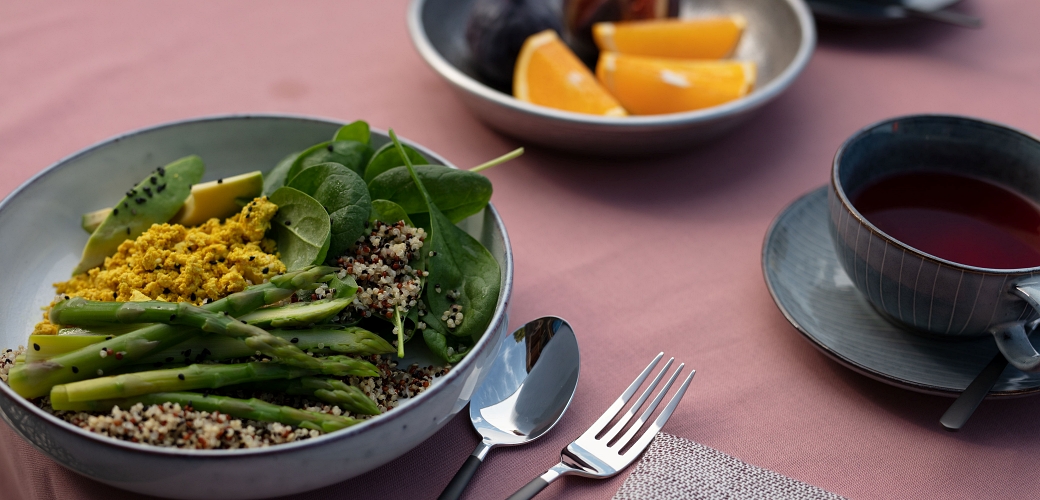
The skin
Skin and nutrition – We are what we eat
Nobody can take their skin off - even if we would love to find an escape sometimes. For example, when those huge pimples explode on our forehead...again. Or if we have an allergic reaction to something and hate the itching, burning, or redness that go along with it. Don’t be surprised if the cause is hidden on your plate. Our skin cares about what we eat.
The outer layer of skin, the epidermis, is constantly being renewed. And this happens very quickly. Every cell is replaced approximately every four weeks. To make this happen, the skin needs “building material”, which is then transformed by the body from food we eat. Many different nutrients are needed. Besides fats, carbohydrates and proteins, micronutrients, such as minerals, vitamins and trace elements, are also important. And the supply comes from eating enough quantities of the right foods. When it comes down to it, it matters to the skin what we eat.
The saying "the mirror of your health is your skin" has its reason. Anyone who wants healthy skin at any age, can’t avoid eating healthy.
Eating healthy is an ongoing issue. Nutrition always comes up again and again because of lifestyle trends and people's growing need for self-optimization: we want to be in good shape and productive as we get older. An ever increasing number of people perceive being vegetarian or vegan as the healthier alternative. This is reinforced by the growing skepticism around industrial food production, intensive agriculture and factory farming.
What does science say? Even though there are many studies and analyses, we are far from a comprehensive and clear picture. Some results are contradictory or too specific to formulate general statements. The thing is, our health is determined by many very different influences. We still don't understand enough about the complex interaction of individual genetic factors, environmental influences and social conditions.
We know a lot about how our metabolism works, what keeps us healthy and what makes us sick. But certainly not everything. Research is still at the beginning of answering many questions. And we should be skeptical about generalizations and big promises made by product manufacturers. Let’s exercize healthy caution and take a closer look at what most people in our culture eat and what impact this could have on our skin’s health.
Carbohydrates
Carbohydrates are abundant in candy, fast food, white flour products and lemonade, for example. The amount we consume is not the only problem, but also the fact that carbohydrates are digested quickly. This causes the blood sugar level to rise rapidly. A chain of effects and interactions are set in motion. The body reacts right away and produces insulin.
Insulin absorbs sugar from the blood and transfers it to the cells. The cells in the skin also absorb some of this sugar. Sebaceous glands grow increasing the risk of acne. Sugar also attaches to proteins and fats, which in turn increases the risk of inflammatory processes in the body. This also happens in the skin accelerating aging.
By reducing fast digesting carbohydrates, you can help improve your complexion significantly. It’s worth trying it out. Instead, switch to more complex carbohydrates found in fruits, vegetables and whole grains as a good option. Why are they better for the body? It’s very simple. The stomach and intestines need more time to digest them. As a result, the blood sugar level rises much slower and the chain of effects described above either does not start at all or only moderately.
Fat
And what about the fat in our diet? We also consume a lot of fat and it’s the number one suspect for health problems. Once again, the answer is: it depends. Saturated fats or trans fats are a problem. They are created during hydrogenation using industrial food processing. These unhealthy fats attack the body’s cells, including skin cells. If they are consumed on a regular basis, the skin ages faster and is prone to inflammatory acne problems.
These unhealthy fats can also be found in fast food, candy and convenience foods. Those who consume a lot, increase their risk of skin problems. Heating healthy vegetable oil too much can also change its chemical make-up and form trans fats. When the oil starts to smoke, you know this has just happened.
As unhealthy as trans fats are, the mono- or polyunsaturated fatty acids are just as important. They protect our DNA and even slow down skin aging. They are indispensable as building materials for new cells, also for the skin. They enable the body to produce neurotransmitters that can influence inflammation. The body can only produce some of these fatty acids itself, so we need to get the rest through our diet.
What do you need to eat to get these "good" fats? You can't go wrong with vegetable sources and seafood. Very good sources include certain ocean fish, fish oil and algae products, also flax oil, walnut oil, nuts and avocados. They contain omega-3 fatty acids. They have an anti-inflammatory effect and can counteract skin problems such as acne, neurodermatitis or psoriasis, alleviating their symptoms.
Protein
More than 20 percent of our body is made up of protein. Proteins are found in every single cell, so it’s important to get enough every day. It supports building muscle as well as repairs and rejuvenates tissue. Protein helps the skin maintain firmness and elasticity.
Essential amino acids play a crucial role. Amino acids are what mainly make up proteins and are found in numerous foods. Dairy products, fish, and meat are abundant in them. Vegetarians and vegans can eat plant-based sources with valuable amino acids such as beans, tofu, nuts, chickpeas, and numerous other such ingredients.
Micronutrients
Micronutrients include vitamins, minerals and trace elements. There are a lot of them and their effects on the skin vary. They prevent skin problems, protect against environmental toxins and maintain cell rejuvenation.
This is just a small sample of the complex relationships between your skin’s health and your nutrition. Knowing this may help you plan a healthier menu.
- Zinc and vitamin A play an important role in skin cell renewal
- Beta carotene protects against UV radiation
- Vitamin C strengthens the connective tissue and helps regulate moisture content and skin growth
- Vitamin E in combination with vitamin C and silica strengthen the connective tissue
- Various B vitamins “work” on the structure of the cells, equip them with defenses and ensure the skin’s healthy balance of oil and hydration
- Vitamin D3, iron and zinc help with wound healing and, just like gamma linolenic acid (GLA), can reduce inflammation
Water
When it comes to skin-friendly nutrition, there is one essential nutrient that can’t be overlooked. Without enough water, people cannot survive. The body of a toddler consists of up to 80 percent water. When people are older, it is around 50 percent. Water is the basic building block for healthy, working cells and a catalyst for most metabolic processes.
Conclusion
The saying "the mirror of your health is your skin" has its reason. Anyone who wants healthy skin at any age, can’t avoid eating healthy.


